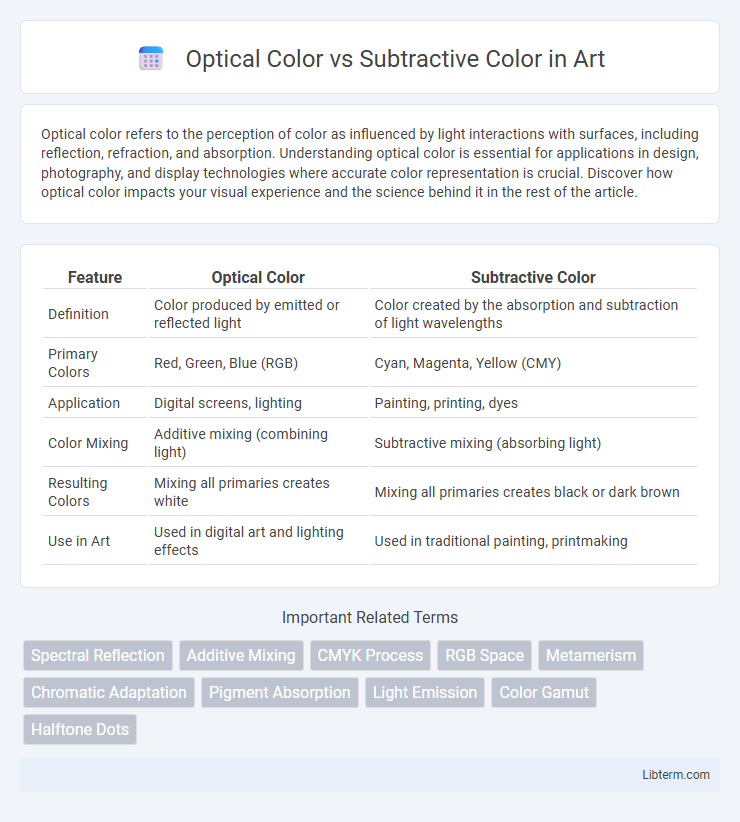Optical color refers to the perception of color as influenced by light interactions with surfaces, including reflection, refraction, and absorption. Understanding optical color is essential for applications in design, photography, and display technologies where accurate color representation is crucial. Discover how optical color impacts your visual experience and the science behind it in the rest of the article.
Table of Comparison
| Feature | Optical Color | Subtractive Color |
|---|---|---|
| Definition | Color produced by emitted or reflected light | Color created by the absorption and subtraction of light wavelengths |
| Primary Colors | Red, Green, Blue (RGB) | Cyan, Magenta, Yellow (CMY) |
| Application | Digital screens, lighting | Painting, printing, dyes |
| Color Mixing | Additive mixing (combining light) | Subtractive mixing (absorbing light) |
| Resulting Colors | Mixing all primaries creates white | Mixing all primaries creates black or dark brown |
| Use in Art | Used in digital art and lighting effects | Used in traditional painting, printmaking |
Introduction to Optical and Subtractive Color
Optical color arises from the reflection and absorption of light waves, creating perceived hues through direct interaction with light sources. Subtractive color involves the mixing of pigments, inks, or dyes, which absorb specific wavelengths and reflect others, resulting in color formation by subtracting certain light components. Understanding the distinction between optical and subtractive color is essential for applications in printing, painting, and digital display technologies.
Understanding Optical Color Perception
Optical color perception involves the way the human eye and brain interpret wavelengths of light reflected or emitted by objects, creating the sensation of color through additive light mixing. Unlike subtractive color, which relies on pigments absorbing specific wavelengths and reflecting others, optical color is perceived through the interaction of light frequencies with photoreceptor cells in the retina. Understanding this process is essential for applications in digital displays, lighting design, and vision science, as it explains how colors are formed and perceived in varying lighting conditions.
What is Subtractive Color Mixing?
Subtractive color mixing occurs when pigments, dyes, or inks absorb certain wavelengths of light and reflect others, resulting in the perception of color by subtracting specific wavelengths from the original light source. This process is fundamental in printing and painting, where cyan, magenta, and yellow are the primary subtractive colors that combine to produce a wide range of hues. Subtractive color mixing contrasts with optical (additive) color mixing, which blends light of different colors rather than filtering it.
The Science Behind Optical Color
Optical color arises from the way light interacts with objects, involving the selective absorption, reflection, and transmission of different wavelengths in the visible spectrum. This phenomenon relies on the physics of light waves and the human eye's perception, where specific wavelengths are detected as distinct colors. In contrast, subtractive color involves pigments or dyes that absorb certain wavelengths and reflect others, altering the perceived color by physically removing components of light.
Pigments and the Subtractive Color Process
Pigments absorb specific wavelengths of light and reflect others, creating colors through the subtractive color process by removing certain wavelengths from white light. This process relies on the combination of cyan, magenta, and yellow pigments, which subtract red, green, and blue light respectively to produce a wide range of colors. Understanding the behavior of pigments is essential for accurate color mixing in printing, painting, and other applications involving subtractive color theory.
Key Differences Between Optical and Subtractive Color
Optical color is based on the emission or reflection of light, such as RGB values used in digital screens where colors are created through light mixing. Subtractive color involves pigments or inks absorbing certain wavelengths and reflecting others, primarily using CMY (cyan, magenta, yellow) to produce color in physical media like printing. The key difference lies in optical color being additive, combining light to create colors, whereas subtractive color works by filtering light through material layers to achieve desired hues.
Optical Color Applications in Art and Design
Optical color, generated through light mixing and additive processes, plays a crucial role in art and design by producing vibrant and dynamic hues that change with light intensity and viewing angle. This technology is widely applied in digital displays, LED lighting, and projection art to create immersive visual experiences that traditional subtractive color methods cannot replicate. Designers leverage optical color's ability to manipulate perception and depth, enhancing interactive installations, fashion textiles, and contemporary artwork with luminous effects.
Subtractive Color in Printing and Painting
Subtractive color in printing and painting relies on the absorption and reflection of light wavelengths by pigments or inks, creating colors by mixing cyan, magenta, and yellow. This process subtracts specific wavelengths from white light, resulting in a range of hues used in physical media. Printing technologies like CMYK utilize this subtractive color model to reproduce accurate, vibrant images by controlling ink density and layering.
Challenges in Using Optical and Subtractive Colors
Optical color, relying on light reflection and perception, presents challenges in achieving accurate color matching due to varying lighting conditions and human visual differences. Subtractive color, dependent on pigment mixing, faces difficulties with color saturation and consistency since physical inks absorb light and can produce muddy or unpredictable hues. Both methods require precise calibration and environmental control to minimize discrepancies and maintain color fidelity in printing, design, and manufacturing applications.
Conclusion: Choosing the Right Color Approach
Optical color relies on light emission and additive mixing, best for digital displays and environments with controlled lighting, while subtractive color depends on pigment absorption and layering, ideal for print media and physical materials. Selecting the right color approach depends on the medium and desired color fidelity; additive methods excel in vibrant, light-based visuals, whereas subtractive techniques offer accurate color reproduction on tangible surfaces. Understanding the fundamental differences ensures optimal color quality and consistency in both digital and physical applications.
Optical Color Infographic

 libterm.com
libterm.com